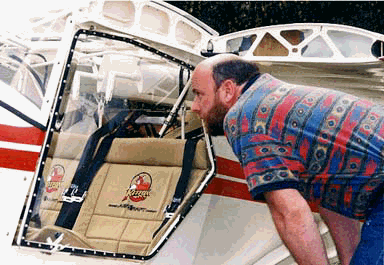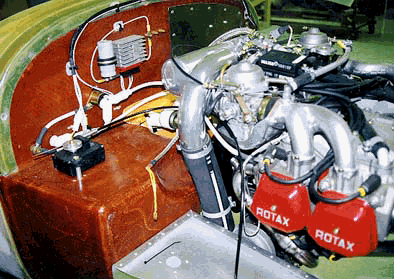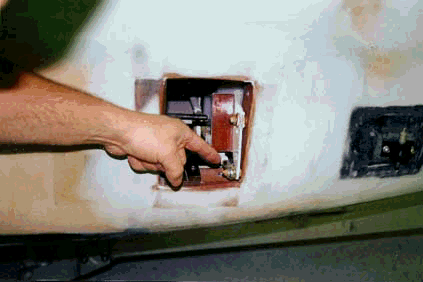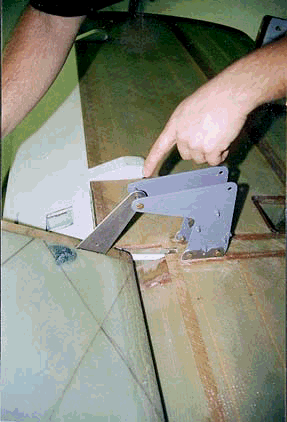Homebuilt Scrutiny: A guide to homebuilt inspections
By Ron Alexander (originally published in EAA Sport Aviation, May 2000)
As mentioned in previous articles, the FAA requires only one inspection of amateur-built experimental aircraft, which takes place after you’ve built it and just before the aircraft is ready for its first flight. During construction, the FAA strongly recommends that builders have knowledgeable people inspect the project, and EAA Technical Counselors usually make these in-process inspections.
Before 1983 the FAA conducted a number of precover inspections, which took place during various stages of construction. Typically, an FAA inspector would scrutinize a homebuilt before the builder closed any surface. For example, if you were building a fabric-covered airplane, the FAA would have to inspect the airplane before you covered any surface with fabric. The FAA performed several similar inspections throughout the building phase, and it inspected the aircraft upon its completion and before issuing the airworthiness certificate.
As interest in aircraft building began to grow in the 1980s, the FAA reassessed the need for precover inspections. Because of the success of EAA’s Technical Counselor program, which dramatically improved the quality of homebuilt construction, in 1983 the FAA decided it would perform only one inspection prior to the initial flight test. To this day, this FAA inspection’s purpose is to ensure that custom builders have constructed a safe and airworthy aircraft.
Although the FAA requires that its personnel perform one inspection, it’s understood that someone other than the builder needs to inspect the project on a regular basis. All builders make mistakes during construction, and without another set of eyes, these mistakes might go unnoticed and uncorrected.
FAA Advisory Circular 20-27D, "Certification and Operation of Amateur-Built Aircraft," says, "In recent years, amateur builders have adopted a practice whereby they call upon persons having expertise with aircraft construction techniques, such as the EAA Technical Counselors, to inspect particular components, e.g., wing assemblies, fuselages, etc., prior to covering, and to conduct other inspections as necessary. This practice is an effective means of ensuring construction integrity."
In another paragraph AC 20-27D says, "Amateur builders should have knowledgeable persons (i.e., FAA-certificated mechanics, EAA Technical Counselors, etc.) perform precover inspections and other inspections as appropriate."
It’s clear that the FAA wants builders to have someone else look over their shoulder during the building of the aircraft. Because builders are concerned with their safety and that of their passengers, they seek these "eyes" and the advice and recommendations a second look often produces. These eyes belong to EAA Technical Counselors.
EAA Technical Counselor Program
Technical Counselors are EAA members who have certain necessary qualifications with regard to aircraft building. These include having built or restored an airplane, or having an Airframe and Powerplant certificate; about half of all TCs have A&Ps. Technical Counselors are volunteers who share their knowledge and experience with builders by inspecting their projects.
These inspections are not formal, paperwork-intensive affairs. They are hands-on, friendly discussions about the best way to build things. Most Technical Counselors specialize in certain construction methods, such as fabric covering, sheet metal construction, composites, etc., and all are expected to have a good grasp of basic aircraft mechanics.
EAA administers this program to ensure that builders present a well-constructed, airworthy aircraft to the FAA for final approval, and to pass on certain aviation knowledge that will further promote safety. The Technical Counselor program provides a means to maintain the excellent reputation that the amateur-built program has earned.
TCs are not allowed to sign Builder’s Logs, and they don’t need to. As the builder, you record the TC’s visit in your log and sign the entry. When it comes time for the FAA inspection, you endorse your project’s airworthiness.
Documenting the Tech Counselor’s visits is important. FAA Order 8130.2D, "Airworthiness Certification of Aircraft and Related Products," guides the FAA inspector through his or her inspection of your project. In Section 7, number 128(a) is says: "The FAA airworthiness certification process will consist of a general airworthiness inspection of the aircraft. This will be accomplished after the aircraft is completed and prior to the issuance of an airworthiness certificate. During this inspection, the FAA should not request extensive disassembly of the aircraft if the builder can provide documented evidence of in-process inspections. The records should indicate what was inspected, by whom, and the date of the inspection." [Emphasis added.]
EAA Technical Counselors do not charge for their services. If a TC must travel some distance to inspect your project, what financial arrangements you make for travel, lodging, and meals is between you and the TC. Most Technical Counselors are members of EAA Chapters, and the easiest way to find the TC in your area is to join the Chapter. You can also find Tech Counselors by location or construction specialty by clicking the members only button on the main page of www.eaa.org. Then select the "aviation advisors" button on the main page of the members-only section, or by calling 920/426-6864.
In some areas an FAA DAR (Designated Airworthiness Representative) will perform your inspection instead of an FAA employee. In either case, do not hesitate to contact your final inspector early in construction, if not when you start work. Forming a relationship with this person is beneficial, and if you feel that he or she should inspect an item prior to the final inspection, then call and ask the inspector to stop by. He or she has the final authority to ensure you are building a safe airplane.
What to Inspect
When it comes to inspections, first-time builders ask, "When do you begin the inspection process and what items should be inspected?"
There is no specific timetable for in-process inspections. They depend on the type of airplane you’re building, the construction methods, and other variables such as your building experience.
For example, if you’re building a tube-and-fabric airplane from plans, a Technical Counselor should inspect your welds after you finish the fuselage. If you’re new to welding, you might want the TC to look at your work after you tack-weld the fuselage or after you complete your first few finish welds. If you’re building a sheet-metal airplane, having a TC inspect the wing spars before you attach the ribs would be a good place to start.
In most cases common sense will almost certainly tell you when to begin this process. It’s never a bad idea to meet with your Technical Counselor before you start construction so the two of you can discuss the project and map out a general inspection schedule in advance. This also is a good way to get valuable building tips that may save you time and frustration later. Meeting with others who are building the same airplane before and during your construction offers the same benefits. You can never have too many sets of eyes looking at your work. The more critical the better. Put your ego aside and let others critique your workmanship.
Component Parts
Overall, in-process inspections concentrate on basic construction techniques and finding problem areas before the area is sealed from later view. The final inspection, accomplished by the FAA, will view more general areas because most of the internal components are not fully accessible during the final inspection.
Technical Counselors should inspect several critical areas before you cover the control surfaces, wings, and fuselage. Inspect the wing spars for any obvious defects, even if the kit manufacturer provided a finished spar. Whether the spar is metal, wood, or composite, thoroughly examine it for damage or defects. If metal, these things may be obvious, but such may not be the case with other materials. Have a Tech Counselor with wood or composite experience inspect it with a critical eye.
Inspect the wing again after attaching all the ribs and running the control cables or tubes. In composite aircraft construction, proper bonding of certain component parts is critical. As you build, make sample layups using the same resins that are used for the bonding so the TC can inspect the samples.
Follow the same sequence for the aircraft’s other major components such as the fuselage, tail feathers, etc. This will entail several Technical Counselor visits, and they are good times to ask any questions you may have. At the same time, if you have questions, don’t wait to ask them. Call the kit manufacturer’s builder-assistance department and/or your TC. Getting answers to questions as they arise keeps construction moving forward and reduces the chance of making mistakes.
Closing Parts
As soon as the Technical Counselor inspects a component’s innards, you can cover or enclose it. Before you do this, however, make your own surgical inspection to make sure you’re not sealing any tools inside a wing or control surface. Like a surgeon who inadvertently leaves something behind, you’ll have to open what you’ve just closed to remove the tool because leaving it there will do damage over time.
After enclosing the component a TC should inspect it again. This examination focuses on the outer skin and makes sure it’s properly attached to the underlying structure. On a sheet-metal airplane the TC is looking for such things as properly spaced and attached rivets. On a fabric airplane the TC is looking for things like proper rib lacing, seam location, and use of finishing tapes.
Assessing the quality of composite construction is more difficult. Layups of reinforcement cloth that are incorrectly applied are often hard to detect. If you have built the part under the right temperature and humidity conditions, you can be somewhat sure that the cloth is properly attached. The inspector will want to look for obvious flaws such as delamination in a skin area.
Regardless of the construction method, at this stage the parts may or may not be painted. Cosmetics are not as important with this inspection as the actual quality of the construction.
Assembly
After you’ve covered all parts with fiberglass, metal, wood, or fabric, it is time to assemble them into an aircraft. Schedule periodic inspection as you assemble the parts because how they are connected is important. The Technical Counselor will be looking for such things as use of the proper hardware, bolt size, and placement and safetying of nuts, etc.
The TC will also want to inspect the control linkages, control surface hinges, landing gear attachment points, and proper wheel alignment. Certainly wing attach and strut attach points should be observed for proper bolts and attachment.
In general, the Tech Counselor should inspect all of the parts as they are assembled before you attach any fairing that would hide component attachments. Schedule these in-process inspections on a regular basis. It’s time for a TC visit when the tail is in place. When the gear is in place-time for a visit. Electrical wiring is another area of concern. Looking for the proper routing of wiring, connections, etc., is very important.
Engine installation is time for another important inspection. Besides the engine mount’s attachment the TC will scrutinize the firewall to ensure that it’s made of the proper material and that grommets protect things passing though it from chafing. The inspection will ensure that fluid lines and filters aren’t located near the exhaust system and that the throttle, mixture, and prop controls are properly routed. Spark plugs should be securely in place and the engine properly grounded. These are just a few examples of items you and the TC must check and recheck to ensure safety. Engine compartments can be very cluttered, requiring close examination to detect potential problems.
Schedule another TC visit when you install the interior, upholstery, instruments, avionics, and other major components that comprise even the simplest airplane. When the airplane is complete, have the TC inspect it one more time, playing the role of the FAA inspector. This prepares you for the last step of the construction process.
Final Inspection Checklist
Naturally, your Technical Counselor performs his or her final inspection before the FAA inspector visits your project for certification. At this point you want as many qualified sets of eyes as you can find to look the aircraft over, and we’ll discuss this phase in detail in an upcoming article.
When you and the TC made your final pre-FAA inspection it’s a good idea to create and use a checklist to make sure you and your project are ready for the FAA and that all the FAA forms, documents, etc., are complete. You should create and start using this checklist when you start construction, not a week before the FAA inspector’s visit, because it will ensure that you’re ready for your certification inspection.
The following generic checklist should aid you in completing the necessary items. Modify it to meet the particular needs of your project.
Prior to Building
• Obtain all forms, advisory circulars, etc., from your local FAA office.
• Contact the FAA Inspector or DAR who will be inspecting your airplane, introduce yourself, and tell the inspector what you’re doing.
• Review the plans and/or assembly manual of your airplane.
• Contact the EAA Technical Counselor/s who will be working with you.
• Review FAA Advisory Circular 20-27D.
• Purchase reference material such as Advisory Circular 43-13.
Building Stage
• Start your Builder’s Log (see March Sport Aviation).
• If you desire a specific N-number, apply for it now.
• Be sure to get a bill of sale from the kit manufacturer.
• Ensure the following items are completed:
Instruments, controls, etc., are properly marked
Emergency Locator Transmitter (ELT) installed
Passenger warning placard installed
Experimental lettering affixed
N-number on the airframe
Identification plate on the airframe
Before Final Inspection
• Complete the Affidavit of Ownership (AC Form 8050-88).
• Fill out the Application for Airworthiness Certificate (FAA Form 8130-6).
• Apply for registration (do this at least 90 days prior to inspection), AC Form 8050-1.
• Fill out the Eligibility Statement-Amateur Built Aircraft.
• Determine where you want to test fly the airplane.
• Compose a letter to accompany the application for airworthiness (a sample may be found in AC 20-27D).
• Send this letter to the FAA inspector or DAR who will perform the final inspection.
• Complete the weight and balance information for your airplane.
• Purchase a logbook for the airframe, engine, and propeller.
Following this simple checklist will assist you in properly preparing for the final FAA inspection. Next month we will take a detailed look at the required items listed above, such as placards, N-numbers, ELT, etc.




